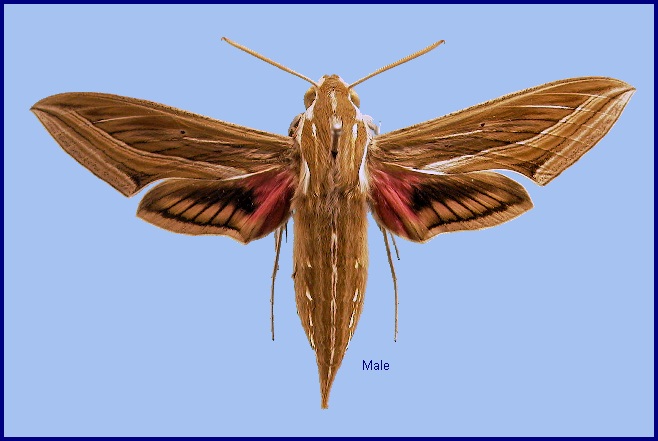
Sphinx celerio Linnaeus, 1758, Syst. Nat. (Edn 10) 1: 491. Type locality: not stated.
Synonym. Sphinx celerio Linnaeus, 1758.
Synonym. Sphinx tisiphone Linnaeus, 1758, Syst. Nat. (Edn 10) 1: 492.
Synonym. Phalaena inquilinus Harris, 1780, An exposition of English Insects: 93.
Synonym. Elpenor phoenix Oken, 1815, Okens Lehrbuch Naturgesch. 3: 760.
Synonym. Hippotion ocys Hübner, [1819], Verz. bekannter Schmett.: 135.
Synonym. Deilephila celerio augustii (Trimoulet, 1858).
Synonym. Deilephila albo-lineata Montrouzier, 1864, Annls Soc. linn. Lyon (2) 11: 250.
Synonym. Hippotion celerio brunnea Tutt, 1904.
Synonym. Hippotion celerio pallida Tutt, 1904.
Synonym. Hippotion celerio unicolor Tutt, 1904.
Synonym. Hippotion celerio sieberti (Closs, 1910).
Synonym. Hippotion celerio rosea (Closs, 1911).
Synonym. Hippotion celerio luecki Closs, 1912.
[Further details on this species in Japan, as well as photos of many stages, can be found on Digital Moths of Japan.]
Wingspan: 60--80mm. Forewing upperside with lower edge of the discal cell highlighted in white and black; discal spot a small but conspicuous black dot; oblique postmedian band also highlighted in silver-white (occasionally reduced), angled at Cu1. Hindwing upperside with a bright pink basal and tornal area; black median and submarginal bands separated by a pink postmedian band that is divided into sharply delimited pink spots by sharp black lines along the veins. Foreleg basitarsus with external row of spines accompanied by a row of smaller spines.
Very similar in appearance to the African Hippotion osiris, but distinguished by its smaller size and black venation on the hindwing. There is some variation in Hippotion celerio. In f. pallida Tutt, a pale terracotta ground coloration is present; in f. rosea Closs, the wings are suffused with red and, in f. brunnea Tutt, with deep brown. In f. augustei Trimoul, the black markings are so extensive as to cover the entire wings; in f. luecki Closs, the silver markings are absent and in f. sieberti Closs, the oblique stripe on the forewing is yellowish instead of silver.
Male genitalia similar to Hippotion velox but uncus shorter and stouter. Gnathos shorter and stouter, much more abruptly narrowed into a sharp hook. Harpe much stouter, almost straight, compressed, upperside hollowed apically, with the edges raised. In the female genitalia, ostium bursae ovate, edges raised to form a low, horseshoe-shaped ridge. Sterigma with no processes.
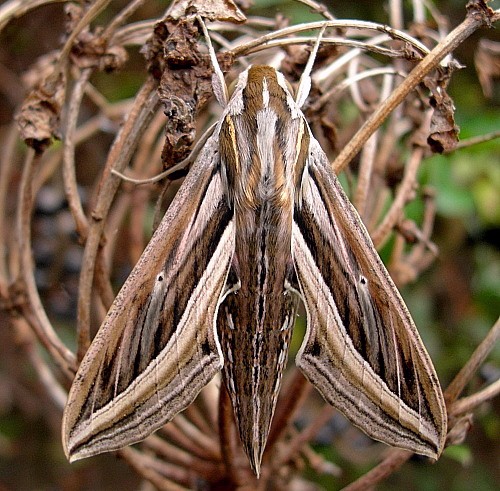
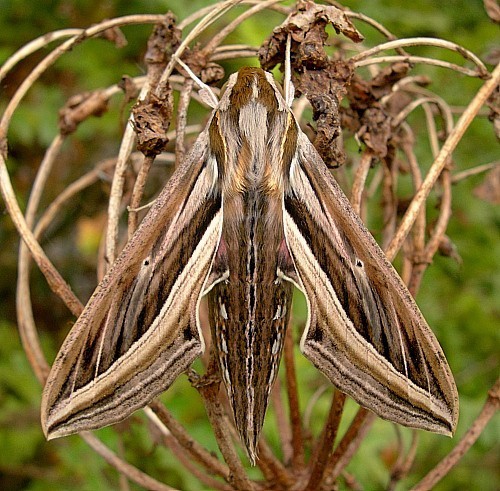
No particular habitat preference is shown by the adult which may occur wherever flower-beds are plentiful; however, for breeding colonies to become established, the presence of cultivated or wild Vitaceae is essential.
Its cryptic coloration, whatever the variation, makes this species difficult to see as it rests during daylight hours on stones, walls, tree-trunks, or amongst foliage. At dusk it takes flight in search of tubular nectar flowers. Although active for only short periods, its powerful and rapid flight enables it to cover great distances; it is frequently attracted to light. Pairing commences a few hours after dusk and lasts only a short time, the pair remaining in copula 1--3 hours.
In Metro-Manila, the Philippines, this synanthropic species is common in suburban parks after 23.00h at flowers of Clerodendrum and Quisqualis indica (Dvořák, 2014).
In northern Borneo, moths of this species are collected when abundant, their heads and wings removed, before being gently fried and eaten (Chey Vun Khen, 2003).
China: iv (Yunnan); viii (Hainan); ix (Yunnan); 29.ix (Hong Kong); x (Guangdong). Taiwan: vi (Tainan). Japan: vii (Ryukyu Archipelago).
OVUM: Variable in size and shape, ranging from near spherical to distinctly oval; clear, glossy, bluish green, assuming a greenish yellow hue prior to emergence. Laid singly on both the upper and lower surfaces of leaves near a growing tip, with rarely more than one to a shoot. The lowest shoots, usually of a vine growing along a wall or fence or along the ground, are preferred. Incubation lasts for 5--10 days.
LARVA: Full-fed 80--90mm. Dimorphic: brown or green. On hatching, the 4mm-long larva is pale yellow with a disproportionately long black horn. It immediately consumes its eggshell, then moves off to find a resting place on the lower surface of a leaf. A period of several hours elapses before any plant material is consumed, after which the body becomes glossy green. In the second instar, eye-spots appear on the first and second abdominal segments; the long dark horn becomes bifurcated at the tip and waves up and down as the larva moves. In the third instar the eye-spots assume their final coloration and a yellow, dorso-lateral line appears, running from thoracic segment 3 to the base of the horn.
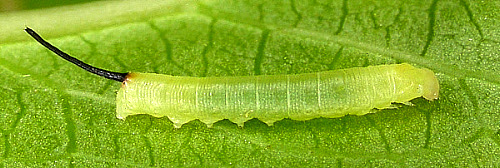
In the final instar most assume a mid- to dark brown coloration, while a few remain green. The head is broadly semi-elliptical; true clypeus an equilateral triangle, one-half length of head; false clypeus forming a semi-elliptical arch over the apex of true clypeus, reaching two-thirds length of head; labrum one-half length of clypeus; ligula slightly longer than labrum, lobes broadly rounded; cutting edge of mandible toothed. Surface of head dull and smooth. Body shaped as in others of the genus; dull and smooth, no visible hairs. Horn straight, of medium length, stout at base, tapering evenly to a blunt tip; covered, except at base, with small tubercles directed distad.
In the green form, head green, labrum and ligula green; basal segment of antenna green, other segments brownish; mandible green, tip narrowly dark reddish brown; eyes brown, except 5, which is black. Body grass-green with an obscure, darker green dorsal stripe. There is an eye-spot on 6 which is longitudinally oval, primrose yellow with a large oval, dark been pupil, the dark green pupil containing five or six round, bluish or pale green dots; the whole edged narrowly with black. The smaller eye-spot on 6 half as long and as broad as that on 5, yellow edged with black, the green pupil. On the abdomen there is a white dorso-lateral stripe from 6 to base of horn, thus stripe sharply defined above, but lower edge diffuse. On segments 7 to 11 there are a number of short, black lines which cross the secondary rings; the subspiracular region is sparsely dotted with white. Horn blackish, base shortly pink; legs red, prolegs and claspers green, venter yellowish-green (Bell & Scott, 1937).
Unlike most other species there is very little change in colour prior to pupation, even in the green form.
As with most larvae exhibiting anterior eye-spots, the head is retracted when the larva is alarmed, expanding the large eye-spots on the first abdominal segment. When feeding, it rarely consumes the whole of a leaf; shoots with quarter- or half-eaten leaves often indicate the presence of a larva. Whereas young larvae may be found beneath a leaf, fully-grown specimens usually rest by day away from the feeding area, farther down the stem, even near the ground.
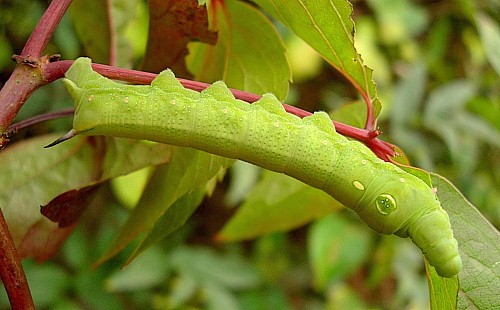
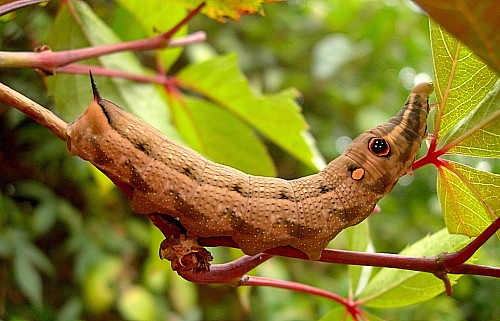
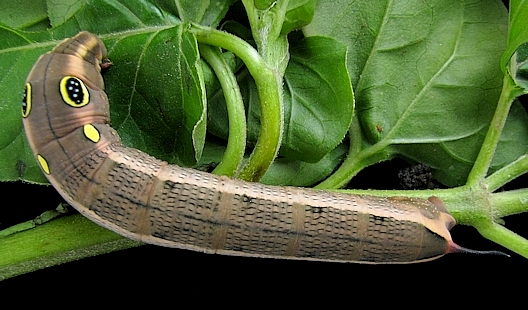
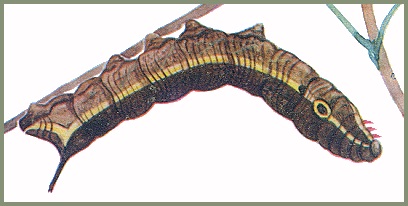
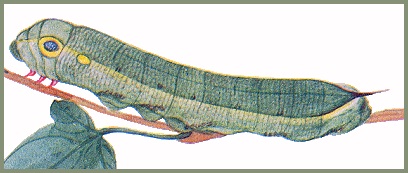
PUPA: 45--51mm. Shape the same as that of Hippotion velox, i.e. proboscis projecting, laterally compressed and cariniform. In colour, tongue-case, legs, antenna and wing-case with a golden lustre; veins and legs dotted with black. Head, thorax and abdomen pale russet brown, darker on dorsum of abdomen, venter of abdomen greyish. An interrupted black ventral stripe is present on segments 8 to 10; there is also a subspiracular stripe of coalescent brown dots. Bevels of segments 8 to 10 brown; spiracles black surrounded by a greyish area dotted with russet; cremaster dark reddish-brown. Surface moderately shiny; head and thorax superficially wrinkled; tongue-case, antenna and wing-case nearly smooth, with a metallic lustre. Abdomen closely, finely transversely corrugate; front bevels of segments 9 to 11 punctate-corrugate. Spiracle of segment 2 a narrow slit covered by a slight, raised emargination of the front margin of 3; remaining spiracles oval, surface slightly depressed. Cremaster triangular at base, but extending into a long, glossy shaft which terminates in a very sharp point; ventral surface slightly hollow. Formed in a loosely spun brown cocoon, either on the ground amongst litter, or just below the surface of the soil. Does not overwinter in the region.
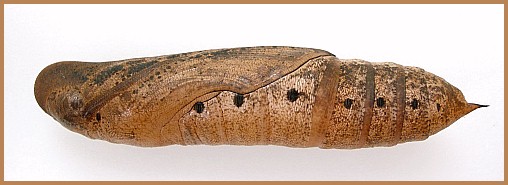
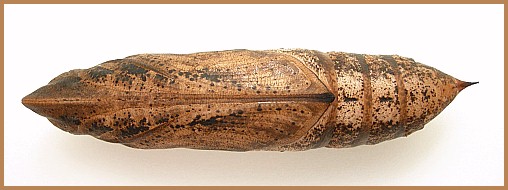
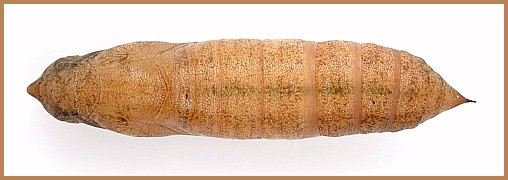
Larval hostplants. Mainly species of Vitis and Parthenocissus. In India also on Spermacoce hispida, Boerhavia, Rumex and Caladium; the latter also in Malaysia (Chey Vun Khen, 2003). In Pakistan, it has also been recorded from Mirabilis jalapa at Islamabad (Muhammad Ather Rafi, pers. comm. 2014).
On Taiwan recorded from Amorphophallus paeoniifolius, Ampelopsis brevipedunculata, Ampelopsis cantoniensis, Causonis japonica [syn. Cayratia japonica], Cissus kerrii, Cissus verticillata [syn. Cissus sicyoides], Colocasia esculenta, Colocasia antiquorum [syn. Colocasia tonoimo], Dendrobium moniliforme, Epipremnum aureum, Impatiens walleriana, Mirabilis jalapa, Morinda citrifolia, Parthenocissus tricuspidata, Pentas lanceolata, Syngonium podophyllum, Typhonium blumei, Vitis thunbergii and Vitis vinifera.
Dvořák (2014) lists Cayratia trifolia and Colocasia esculentaas the main hosts for Metro-Manila, the Philippines, as well as Mitragyna speciosa, Pisonia grandis [syn. Pisonia morindifolia] and Ceodes umbellifera [syn. Pisonia alba; syn. Pisonia umbellifera]. On the latter two species, often in the company of Hippotion velox.
Braconidae: Meteorus stellatus Fujie, Shimizu & Maeto, 2021.
China: Sichuan (Huili); Yunnan (Dali; Gaoligong Shan; Kunming; Menglunzhen; Jinghong; Yongsheng, Lijiang); Xizang/Tibet (Nyingchi/Linzhi, Namjagbarwa region, 3050m; Yadong, 2900m; Zhangmu, 2200m); Hunan; Guangdong; Hong Kong; Hainan (Jianfengling National Forest Park).
Taiwan: Tainan; Taipei; Hualien; Taitung; Kaohsiung; Chiayi; Huwei; Tianwei; Taichung; Hsinchu; Luodong; Douliu.
Japan: Ryukyu Archipelago (Okinawa; Amami Oshima; Iriomote-jima; Ishigaki-jima); Kyushu (Kagoshima).
Originally a rare migrant to southern China, Taiwan and southern Japan. It was recorded from the latter country for the first time in 1988 (Masaya, 1990). Now firmly established and common across Taiwan and Okinawa.
Tropical Africa (including Ascension Island, Madagascar and the Seychelles (Matyot, 2005)), tropical Asia and Australia eastwards to Rapa Iti, French Polynesia (Clarke, 1971), with occasional records from northern New Zealand.
A notable migrant in most years from Africa, India and South East Asia north into the Palaearctic region.
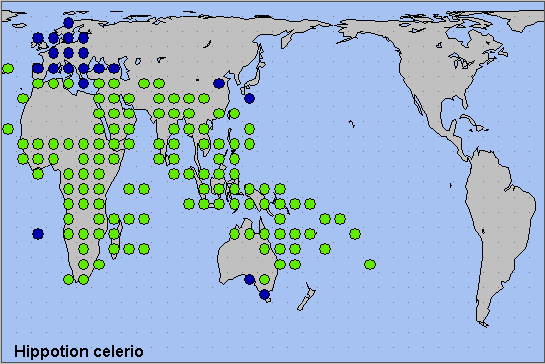
Palaeotropical.
 Return to Sphingidae of the Eastern Palaearctic species list
Return to Sphingidae of the Eastern Palaearctic species list